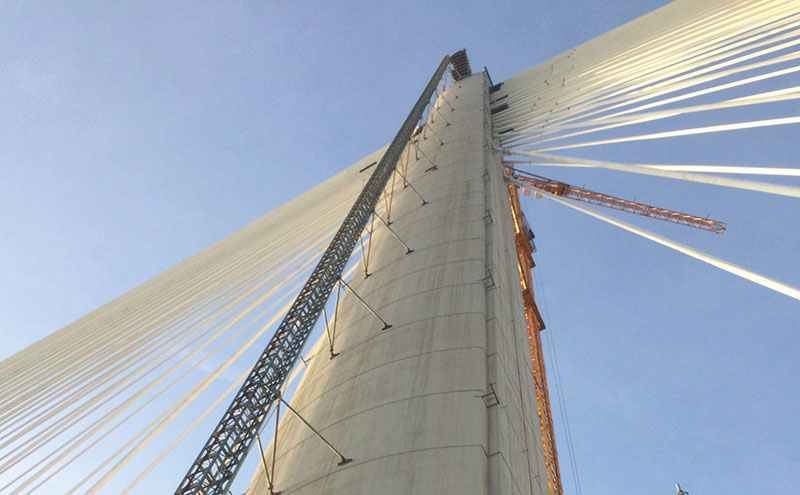
The Queensferry Crossing is set to become the longest three-tower, cable-stayed bridge in the world upon its completion in May 2017, writes Ronnie Turner, infrastructure manager at global building product manufacturer, Sika
A wonder of modern engineering and technical ingenuity, the 1.7-mile, £790 million structure (total project value £1.35 billion) will make for an awe-inspiring sight for the thousands of motorists who are anticipated to cross its deck on a daily basis or those who simply like to stand and gaze at breath-taking constructional feats.
Behind every spectacular landmark lies a seemingly endless list of unsung heroes; from designers and on-site construction teams that transform fantastical ideas to reality, to the materials used to ensure a building or structure is as safe, reliable and long-standing as it is inspiring to look at.
TAKING THE STRAIN
Queensferry Crossing’s three towers will stand up to 210 metres above high tide – the equivalent of 48 London buses stacked on top of each other. They are also 50 metres (or 25%) higher than its neighbouring crossing, the Forth Road Bridge and about double the height of the cantilevers on the world famous Forth Bridge. In addition to the main towers, ensuring this mammoth monument is able to fulfil its long-term duty as a speedy travel link between Lothian and Fife, is a total of ten concrete piers.
Some emerging from the water, others from land, these piers support the crossing’s north and south approach viaducts. Acting as a middle material between the crossing’s deck and the piers, and absorbing the gargantuan pressure of both, are PTFE bearing pads.
Absolutely critical to the crossing’s design, these components’ creation required a substance designed to be even tougher than concrete.
Consultant engineers on behalf of the Forth Crossing Bridge Constructors (FCBC) consortium, which is responsible for Queensferry Crossing’s construction for client Transport Scotland, along with its connecting roads, specified Sika Armorex L2 High Flow grout between the PTFE bearing pads and the top of the piers.
SIMPLICITY EQUALS STRENGTH
A one-component cementitious grout, it is an incredibly strong material with a proven track record for precision, high-performance grouting beneath all types of structural steelwork. Before installation, and with the crossing’s stability literally resting on the grout-based, bridge-bearing pads beneath it, structural engineers carried out a testing programme on each batch of Sika Armorex L2 High Flow.
As can be imagined, analysing huge volumes of cementitious grout to identify potential failures proved extremely time-consuming, and presented the biggest challenge to engineers when it came to installing the bridge-bearing pads and supporting grout. It was a vital element of the installation process, however, as safety on a project of this size and profile was of the highest priority.
As well as its high-strength and durability, the sustainability of Sika Armorex L2 High Flow makes it an attractive proposition for specifiers on large-scale building projects. It is free of toxins such as chloride, thus eliminating a potential threat to wildlife in areas of rural or waterside construction.
LANDMARK FIGURES
When it comes to gauging the stature of this superb structure, consider the following statistics: An estimated 150,000 tonnes of concrete will be poured during its construction, whilst 35,000 tonnes of steel will form the bridge deck – the equivalent weight of nearly 200 Boeing 747s.
The combined steel required for the crossing’s north and south viaducts weighs 10,000 tonnes.
The crossing is due to open in May 2017, when its ‘slender and elegant’ towers will oversee two lanes of north and south-bound motorway. It will signal the end of a near six-year works programme, an intense and collaborative venture, planned and implemented by an international consortium of construction experts.
The resulting structure will dwarf the existing Forth Road Bridge in height and possibly splendour, but whilst we acknowledge the magnificence of the soon-to-be-opened crossing and the technological excellence that will eventually bring this unique and much-needed transport courier to life, let us not forget the building materials that hold it together, helping cement its place in Scotland’s infrastructural history.








